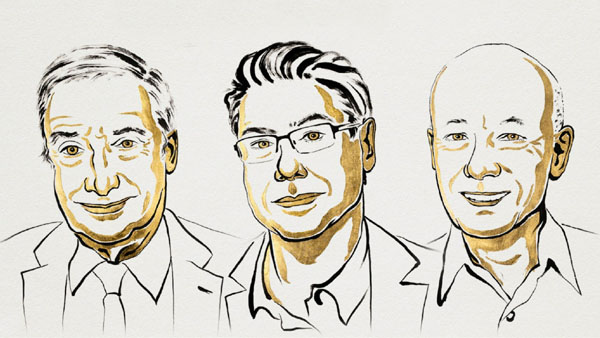By Satyabrat Borah
On October 13, 2025, the Royal Swedish Academy of Sciences announced the recipients of the Sveriges Riksbank Prize in Economic Sciences in Memory of Alfred Nobel, commonly known as the Nobel Prize in Economics, honoring three distinguished scholars for their profound insights into the engines of modern prosperity. Joel Mokyr, Philippe Aghion, and Peter Howitt were recognized for having explained innovation-driven economic growth, a theme that resonates deeply in an era where technological leaps from artificial intelligence to renewable energy are reshaping societies. One half of the prize, worth 11 million Swedish kronor or about 1.2 million dollars, goes to Mokyr for identifying the prerequisites for sustained growth through technological progress, while the other half is shared by Aghion and Howitt for developing the theory of sustained growth through creative destruction. This award not only celebrates their individual brilliance but also underscores a unified narrative: innovation is not a random spark but a systematic force propelled by culture, competition, and disruption, lifting billions from poverty over the past two centuries.
Joel Mokyr, born in 1946 in Leiden, the Netherlands, to a family of Dutch Jews who endured the Holocaust, embodies the resilient spirit his work often chronicles. Raised in Haifa, Israel, after his father’s early death, Mokyr pursued a bachelor’s degree in economics and history at the Hebrew University of Jerusalem in 1968, followed by a master’s and doctorate from Yale University in 1974. His academic journey led him to Northwestern University, where he has been a professor of economics and history since 1974, ascending to the Robert H. Strotz Professorship of Arts and Sciences. At 79, Mokyr is a towering figure in economic history, having supervised nearly 50 doctoral dissertations and mentored scholars now at institutions like Stanford and Yale. His accolades include the 2006 Heineken Prize from the Royal Dutch Academy of Sciences and the 2015 Balzan International Prize for Economic History, a decennial honor. As editor-in-chief of the Princeton Economic History of the Western World series since 1993 and former co-editor of the Journal of Economic History, Mokyr has shaped the field profoundly.
Mokyr’s contributions center on unraveling why the Industrial Revolution ignited in Europe around 1800, sparking sustained economic expansion unprecedented in human history. Prior to this era, growth was episodic, confined to trade booms or agricultural yields, but never self-perpetuating. In works like The Lever of Riches: Technological Creativity and Economic Progress, published in 1990, Mokyr argues that technological change is the ultimate driver of wealth, yet it demands fertile ground. He draws on vast historical archives, from medieval guild records to Enlightenment correspondence, to show that innovation thrives not in isolation but within a web of social norms and institutions. Central to his thesis is the concept of a “culture of growth,” detailed in his 2016 masterpiece A Culture of Growth: The Origins of the Modern Economy. Here, Mokyr posits that between 1500 and 1700, a unique intellectual ecosystem emerged in Western Europe, particularly in the Dutch Republic and Britain. This Baconian culture, inspired by Francis Bacon’s empirical ethos, fostered a republic of letters: polymath networks of scholars, inventors, and entrepreneurs who shared knowledge freely, challenging ancient authorities like Aristotle while embracing experimentation.
What set this apart from other civilizations, such as Ming China or the Ottoman Empire, where technical prowess existed but stagnated? Mokyr identifies two intertwined prerequisites: openness to novelty and resistance to rent-seeking. In Europe, the Reformation and Scientific Revolution eroded dogmatic barriers, encouraging what he calls “proposition-making” and “proposition-rejecting” among intellectuals. Universities and academies, like the Royal Society in London founded in 1660, became hubs where dissent was valued, not punished. Meanwhile, political fragmentation prevented any single power from stifling progress; competitive city-states and nations vied for talent, much like modern Silicon Valley. Mokyr’s analysis extends to institutions: property rights, patent systems, and markets incentivized inventors, but only because cultural norms deemed useful knowledge a public good. In The Enlightened Economy: An Economic History of Britain 1700-1850, published in 2009, he dissects Britain’s ascent, crediting not just coal and iron but a “useful knowledge” ethos that integrated science with commerce. Figures like James Watt or Matthew Boulton succeeded because society celebrated tinkerers as heroes, not heretics.
This historical lens reveals timeless lessons. Mokyr warns that without cultural commitment to truth-seeking, even abundant resources falter; he contrasts Europe’s trajectory with Latin America’s colonial extractivism, where elite capture choked innovation. His work bridges cliometrics, the quantitative rigor of economic history, with qualitative narratives, influencing debates on why some nations converge while others diverge. In an age of populism and anti-science rhetoric, Mokyr’s emphasis on epistemic openness feels urgent, reminding policymakers that growth is as much a mindset as a metric.
Complementing Mokyr’s historical sweep are the theoretical foundations laid by Philippe Aghion and Peter Howitt, whose collaboration formalized the mechanics of innovation as an endogenous force within economies. Born in 1956 in Paris, Aghion, now 69, earned his doctorate from Harvard in 1987 and holds professorships at the Collège de France, INSEAD, and the London School of Economics. His career spans contract theory, where early papers with Patrick Bolton and Oliver Hart explored incomplete contracts in corporate finance, to growth economics. Peter Howitt, born in 1946 in Canada and also 79, received his PhD from Northwestern in 1973 and has taught at Brown University since 2002, following stints at the University of Western Ontario. A specialist in macroeconomics, Howitt’s pre-collaboration work examined monetary policy and unemployment. Together, their partnership, sparked in the late 1980s, revolutionized endogenous growth theory, shifting focus from exogenous shocks to internal dynamics.
Their seminal 1992 paper in Econometrica, “A Model of Growth Through Creative Destruction,” built on Joseph Schumpeter’s 1942 vision of capitalism as a gale of destruction where new ideas obliterate the old, fostering progress. Before Aghion and Howitt, growth models like Robert Solow’s assumed technology as a black box, externally imposed. The duo’s breakthrough was a mathematical framework integrating microeconomic competition with macroeconomic outcomes. Imagine an economy of monopolistic firms producing intermediate goods; incumbents earn rents from existing technologies, but entrepreneurs invest in R&D to invent superior versions, capturing markets. Innovation arrives stochastically, with probability tied to research spending, but success destroys prior monopolies, yielding “creative destruction.” This cycle generates sustained growth rates proportional to innovation incentives, without diminishing returns plaguing older models.
Formally, their model posits aggregate output Y as a function of labor L and a productivity index A, where A evolves via a Poisson process: each innovation boosts A by a factor γ > 1, but at the cost of obsolete capital. The arrival rate λ depends on aggregate R&D effort, balanced against the expected profits from displacing incumbents’ value V. Equilibrium growth g equals λ log γ, endogenously determined by parameters like competition intensity and imitation risks. Aghion and Howitt extended this in their 1998 book Endogenous Growth Theory, incorporating variety expansion, spillovers, and policy levers. They showed how stronger intellectual property rights accelerate growth by raising innovator rents, yet excessive protection entrenches incumbents, stifling entry. Competition policy emerges as a tightrope: antitrust laws spur disruption by lowering entry barriers, but overregulation deters R&D.
Their framework’s power lies in empirical traction. Later works, like Aghion’s 2005 Handbook of Economic Growth chapter with Steven Durlauf, tested predictions using firm-level data, confirming that industries closer to technological frontiers innovate more under threat. Howitt’s solo extensions, such as in Frontiers of Economic History, linked creative destruction to business cycles, where booms fund riskier bets. Aghion, in the 2010s, pivoted to inequality and political economy, co-authoring The Power of Creative Destruction in 2021 with Céline Antonin and Simon Bunel. This volume applies their model to automation and AI, arguing that while superstars like tech giants amplify growth, they widen wage gaps; policies like retraining and progressive taxation can mitigate without curbing dynamism. Howitt’s contributions emphasize human capital’s role, showing how creative destruction reallocates skilled labor, explaining skill-biased technical change.
The Nobel committee lauded Aghion and Howitt for bridging theory and reality, providing tools for central banks and governments to nurture innovation. Their model informs debates on subsidies for green tech or antitrust suits against Big Tech, quantifying how Silicon Valley’s churn drives GDP while displacing workers. As Aghion noted upon the announcement, the prize was a “huge surprise,” yet it validates decades of bridging abstract math with policy urgency.
Together, these laureates weave a tapestry from past to future. Mokyr supplies the historical soil, Aghion and Howitt the seeds and storms of disruption. Their synthesis explains why Europe diverged after 1800: not geography or coal alone, but a culture enabling Schumpeterian gales. In today’s context, amid climate crises and geopolitical tensions, their work urges fostering open inquiry and competitive markets. Mokyr’s republic of letters echoes in open-source code; Aghion-Howitt dynamics in EV battery races. Yet challenges loom: global south nations must cultivate their own growth cultures, while advanced economies balance disruption with equity. As Howitt reflects, innovation creates winners and losers, demanding institutions that share the pie. This Nobel arrives as economies grapple with post-pandemic recovery and AI’s dawn, affirming that understanding growth’s roots is key to equitable progress. Mokyr, Aghion, and Howitt remind us: prosperity is no accident, but a deliberate harvest from sown ideas and bold upheavals. Their legacy will guide scholars and leaders, ensuring innovation’s flame endures.




